
作者:Kevin Otto,美国GS1 社区参与高级总监,翻译:王国文,中国(深圳)综合开发研究院物流与供应链管理研究所所长
It’s a technology that has been heavily publicized and scrutinized over the past two years, diversely described as either the next big thing or a complex rabbit hole.
这项技术在过去两年中被广泛宣传和仔细研究,也被反差十足的描述为下一个大事件,或者是复杂的“兔子洞”。
Depending on your point of view, and most importantly, depending on what problem you’re looking to solve, blockchain is emerging as a potentially powerful tool. On the surface, the list of benefits sound promising and many of them could be truly revolutionary. Blockchain can:
取决于您的立场,最重要的是,您需要什么问题,区块链正在成为一个强大工具。显而易见,区块链所带来的好处可以拉出一个长长的案子,其中很多是真正的革命性的。区块链可以:
help the supply chain finally modernize and move away from paper systems.
帮助供应链最终实现现代化并彻底实现无纸化
help companies better align with consumer demand for information transparency.
帮助公司更好地满足消费者对信息透明度的需求。
lead to more accountability in the supply chain by creating an immutable ledger or audit trail of product events and transactions.
通过创建不可串改的分类账本或产品事件和交易记录的审计记录,增加供应链的可信度。
However, it’s important to keep in mind that it is still a nascent technology with many unknown consequences and considerations attached to it.While some companies are pursuing blockchain quite confidently after use cases have been proven, many others are finding out that it’s really not a magic problem solver. They have ended up learning more about their systems’ability to share data externally, their trading partners’data sharing capabilities, and have encountered serious data quality issues and inconsistencies.
然而,我们需要知道的是,它仍然是一种新兴的技术,有许多未知的后果和不成熟之处。虽然一些公司在尝试后相当自信地追求区块链,但许多其他公司发现它确实不是一个神奇的问题解决者。他们调研了系统对外共享数据的能力、贸易伙伴的数据共享能力,发现了严重的数据质量问题和不一致性。
The onus today is on industry to complete its due diligence in these areas before making serious commitments to blockchain technology and advocate for greater interoperability.With the global blockchain supply chain market expected to reach over $9 billion by 2025, according to Allied Market Research (AMR), it’s critical for supply chain teams to clearly define success now and determine if blockchain is the right path forward and the best use of their budget dollars.如今,业界有责任在对区块链技术作出保障之前对这些领域的详细调查,并倡导提高交互操作。据联合市场研究机构(AMR)称,到2025年,全球区块链供应链市场预计将达到90亿美元以上。对于供应链团队来说,给与区块链明确的定义,确定区块链是否是正确的前进道路,以及如何最好地利用他们的预算资金尤为重要。
One common thread between those who expand their blockchain implementations and those who pull back on blockchain is the essential foundation for data quality and systems interoperability enabled through GS1 Standards. As the most widely-used supply chain standards system in the world, GS1 Standards have been leveraged by industry for more than 45 years.
在那些扩展区块链的公司和那些退出区块链的公司之间,一个共同的主线是通过GS1标准支持数据质量和系统交互性的基本基础。GS1标准作为世界上使用最广泛的供应链标准体系,已经被业界使用了45年多。
Several GS1 Standards make up the building blocks of blockchain, as they provide consistency and structure to data transactions on a blockchain, increasing the likelihood that the intended outcome will be achieved.
某些GS1标准构为区块链上的数据交易提供了一致性和系统,成为区块链的构建模块,从而增加了实现预期效果的可能性。
As you evaluate blockchain, consider your organization’s adherence to these key standards that are foundational to nearly every blockchain supply chain use case— including traceability, product provenance, preventing the circulation of counterfeit goods, and more.
在您评估区块链时,请考虑您的公司是否遵守这些关键标准,这些标准几乎是每个区块链供应链用例的基础—包括可追溯性、产品来源、防止假冒商品的流通等等。
区块链成功的关键标准
KEY STANDARDS FOR BLOCKCHAIN SUCCESS
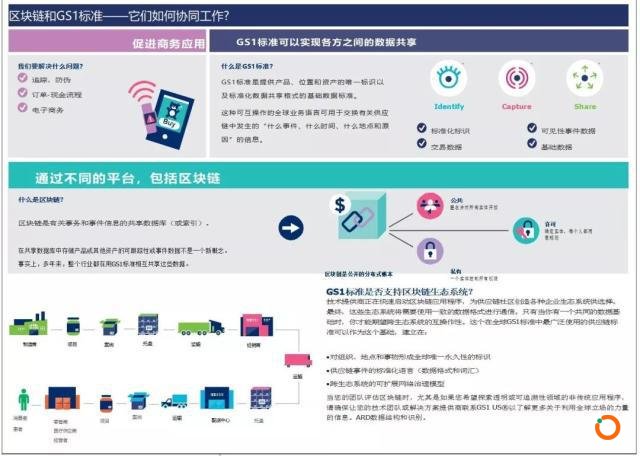
Global Trade Item Numbers (GTINs) – These identification numbers are what power global commerce and help businesses manage products on the physical and digital shelf. If every item is uniquely identified with its own GTIN, it retains an identity regardless of where it is in the supply chain.
全球贸易项目编号(GTINs)–这些识别码是推动全球商业的动力,帮助企业管理物理和数字货架上的产品。如果每个项目都有自己的GTINs唯一标识,那么不管它在供应链中的位置如何,它都会保留一个标识。
Identification that is persistent beyond the four walls of the company is key for a blockchain implementation. A blockchain is composed of “blocks” of data stored on a “chain,” i.e. a decentralized ledger. It creates an immutable record so the blocks need to contain a universal data language starting with product identification to ensure that the right data is stored and communicated further down the chain.
对于区块链的实现来说,改变公司封闭的识别代码是关键。区块链由点缀在“链”上的数据“块”组成,即分散的分类账户。它成为了一个不可变的记录,因此“块”需要包含一个从产品标识开始的通用数据语言,以确保正确的数据在链下进一步存储和通信。
Global Location Numbers (GLN) – Similar to GTINs, these are numbers that uniquely identify organizations and locations in the supply chain.
全球定位编号(GLN)-与GTINs类似,这些编号唯一地标识了供应链中的组织和位置。
GLNs give companies the flexibility to identify any type or level of location required for supply chain visibility.They can identify a warehouse, a restaurant, a retailer, a hospital, even something as specific as a store shelf. Or, they can identify a company’s legal or functional entities as they relate to a particular business transaction, for example as buyer, seller, or carrier.
GLNs使企业能够灵活地识别供应链可视性所需的任何类型或级别的位置。它们可以识别仓库、餐馆、零售商、医院,甚至是像商店货架这样特定的东西。或者,它们可以识别与特定业务交易相关的公司的法律实体或功能实体,例如买方、卖方或承运人。
Why is this important for blockchain? The most popular use cases in blockchain today revolve around supply chain visibility with specific focus on locations and origins. For example, a food recall use case requires location accuracy, as we saw with Walmart’s early mango blockchain pilot where the retailer’s supply chain team was challenged to trace mangos from a supplier in Mexico to a US store. It’s equally necessary to reveal a product’s specific origin, as in Cargill’s turkey tracing app, where consumers could find out the exact farm where their Thanksgiving turkey was raised.
为什么这对区块链很重要?时下区块链中最重视供应链的可见性,特别是关注位置和来源。例如,正如我们在沃尔玛早期的芒果区块链试点中看到的那样,一个食品召回需要位置准确性,零售商的供应链团队受到挑战,要将芒果从墨西哥的供应商追溯到美国的商店。同样有必要披露产品的具体产地,比如在嘉吉百货的火鸡追踪应用程序中,消费者可以查到他们购买的感恩节火鸡饲养的确切农场。
GS1 barcodes – For data to be shared among trading partners (with or without a blockchain), it must be captured. It’s a given that most companies use the U.P.C. seen at checkout. But for supply chain visibility purposes, more trading partners, particularly in the food industry, are leveraging the GS1-128 barcode, to capture dynamic product information and serialized logistics data, such as expiration date,and batch/lot numbers. Using these barcode labels, companies enable the automatic recording of product-specific information whenever a barcode is scanned, for a more real-time view of where products have been and where they are going.
GS1条形码–考虑到大多数公司都使用U.P.C.,所以不管有没有区块链,必须要共通的数据识别,在贸易伙伴之间共享数据。但出于供应链可见性的目的,更多的贸易伙伴,特别是食品行业的贸易伙伴,正在利用GS1-128条形码来捕获动态产品信息和序列化的物流数据,如有效期和批次/批号。使用这些条形码标签,公司可以在扫描条形码时自动记录特定于产品的信息,以便更实时地查看产品的位置和去向。
Electronic Product Code Information Services (EPCIS) - One particular standard has been cited by those piloting blockchain programs as essential to maintaining the proper flow of data. EPCIS is a GS1 Standard that supports the exchange of physical event data and is increasingly deployed in sectors such as fresh foods, healthcare, and logistics to improve efficiency in areas ranging from inventory management to consumer and patient safety. It has been used to enable significant improvements in transactional data sharing.
电子产品代码信息服务(EPCIS),这一特殊的标准已经被那些试点区块链项目引用,作为维持适当数据流的必要条件。EPCIS是支持物理事件数据交换的GS1标准,并且越来越多地部署在新鲜食品、医疗保健和物流等部门,以提高从库存管理到消费者和患者安全等领域的效率。它已被应用于交易数据共享方面,并且有了显著的改进。
At its core, EPCIS is like a standardized application program interface (API). Typically, an API is used to specify how software components should interact. EPCIS acts in a similar way to capture and share information about the movement and status – the what, where, when and why – of products, logistics units and other assets in the supply chain. EPCIS simplifies the capture and description of events that are written and companies can more instantly rely on a single version of the truth about supply chain and logistics events. Also, it can be implemented with a number of different data carriers, including GS1 barcodes and EPC-enabled.
EPCIS 的核心是一个标准化的应用程序接口(API)。通常,API用于指定软件组件应如何交互。EPCIS 以类似的方式来捕获和共享有关产品、物流单元和供应链中其他资产的转移和状态(什么、在哪里、何时以及为什么)的信息。EPCIS简化了对编写的事件的捕获和描述,公司可以更快速地依赖于关于供应链和物流数据的汇总来了解事件最真实的情况。此外,它还可以用许多不同的数据载体来实现,包括GS1条码和EPC。
radio frequency identification (RFID). Unlike “batch oriented” data transmission mechanisms, EPCIS is more suitable for blockchain because it more efficiently documents the potentially massive amounts of event-based data.
射频识别(RFID)。与面向批量处理数据传输机制不同,EPCI更适合于块链,因为它可以更有效地记录潜在的大量基于事件的数据。

为什么这么急迫
WHY THIS IS URGENT
We are at a critical moment in blockchain scalability where companies are still determining which aspects of blockchain work for an enterprise supply chain setting. The automation advances brought by smart contracts alone are valuable for some, while others may find more inherent value in the entire blockchain ecosystem.The complex needs of different supply chains require the development of solutions that make sense for different use cases and industries. As those solutions are developed, it’s important to prepare data and organizational teams now. Simply rushing into blockchain without first adapting legacy systems and processes for less manual involvement will not yield a successful outcome.
我们正处于区块链发展的关键时刻,公司仍在决定区块链的哪些方面适用于企业供应链环境。单靠智能合约带来的自动化进步对一些人来说是有价值的,而另一些人可能会在整个区块链生态系统中发现更多内在价值,不同供应链的复杂需求需要开发出对不同用例和对行业有意义的解决方案。随着这些解决方案的开发,现在准备数据和组织团队非常重要。如果只是匆忙进入区块链,而不首先调整遗留系统和流程以减少人工参与,将不会成功。
Recent studies confirm this. A survey from the World Economic Forum and Accenture found that while respondents expected a 24% return on investment (ROI) on their early blockchain projects, they only saw a 10% return on average. Industry stakeholders interested in blockchain should learn from this early stage and prepare accordingly to maximize ROI.
最近的研究证实了这一点。来自世界经济论坛和埃森哲的一项调查发现,虽然受访者预期其早期区块链项目的投资回报率(ROI)为24%,但他们的平均回报率仅为10%。对区块链感兴趣的行业利益相关者应该从早期阶段学习,并相应地准备最大化投资回报率。
Ultimately, no matter what happens with blockchain, its presence is forcing an important conversation around the long overdue modernization of the supply chain. By bringing more trading partners together, blockchain has reignited interest in data sharing and interoperability that can eventually reduce friction in the supply chain and create the agility needed to align with consumer needs. Now is the time to stay educated on blockchain and continue to evaluate its value to overall supply chain goals.
最终,不管区块链发生了什么,它的存在正迫使供应链摆脱长期滞后的局面,积极地对现代化进程展开对话。通过将更多的贸易伙伴聚集在一起,区块链重燃了对数据共享和交互性的兴趣。最终可以减少供应链中的摩擦,并创造与消费者需求相一致所需的灵活性。现在是时候继续学习区块链知识,并继续评估其对整个供应链目标的价值。
本文地址: https://www.xiguacaijing.com/news/xingye/2019/13187.html

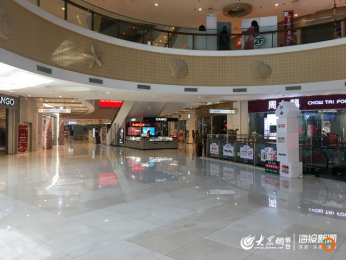
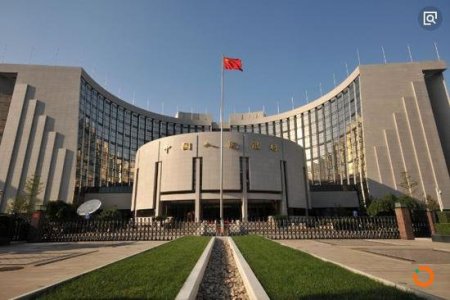

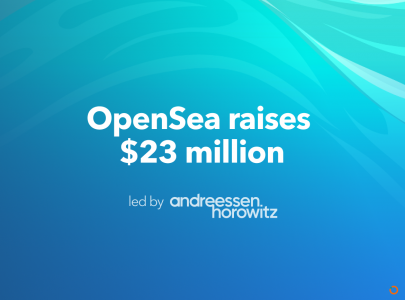
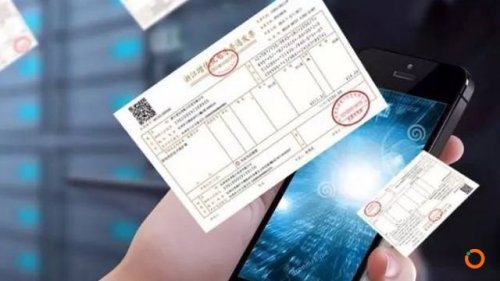




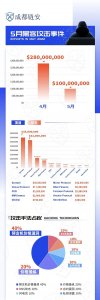



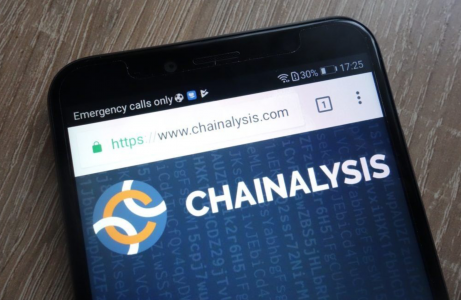


赞助商